OWC ThunderBay Flex 8
Support Manual
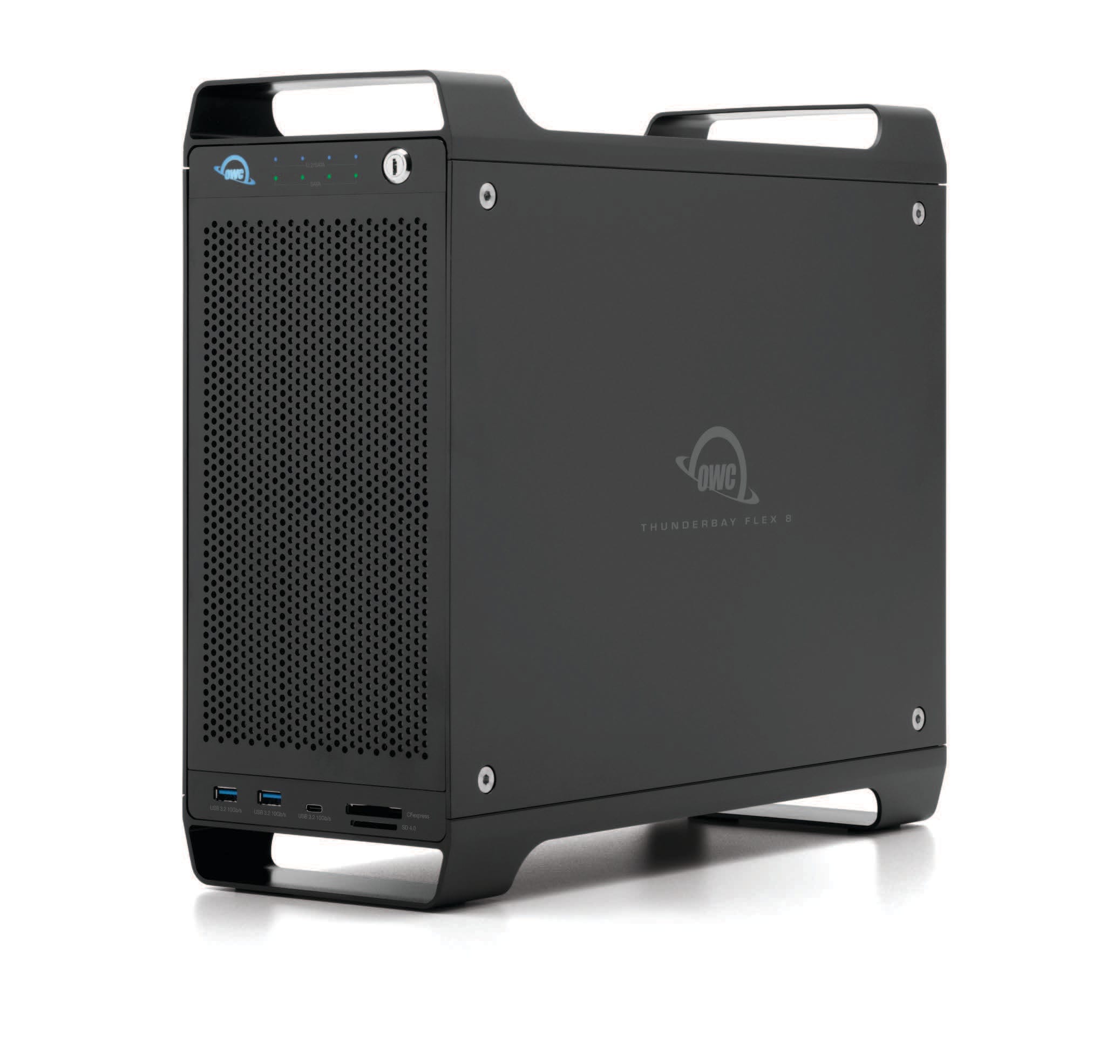
Introduction
1.1 System Requirements
Operating System
- macOS 10.15 or later
Hardware
- Mac with Thunderbolt 3
Supported Drives
- 4 Upper Bays: 3.5”/ 2.5” SATA, SAS, and NVMe U.2 SSDs/adapters
- 4 Lower Bays: 3.5”/ 2.5” SATA and SAS drives
Supported Flash Media
- SD (up to 4.0 UHS-II) cards
- CFexpress (Type B) cards
Supported PCIe Devices
- Dimensions: Supports one card up to half-length, single-width, full-height
- Mechanical: x16 PCIe slot
- Electrical: x4 PCIe 3.0
- NOTE: Cards with drivers must be Thunderbolt-aware & GPUs are not supported
1.2 Package Contents
- (1) OWC ThunderBay Flex 8
- (1) Thunderbolt cable
- (1) External power supply
- (1) Power cable
- (2) Security lock keys
- (1) 3 Years of SoftRAID Premium Access (License located on bottom of device)
1.3 Front View
- Power LED – LED will display white when powered on without a data connection. The LED will display blue when powered on with a data connection.
- Drive Status LEDs – The top row of (4) LEDs display the status of NVMe U.2 SATA drives and flash blue. The bottom row of (4) LEDs display the status of SATA drives and flash green.
- Security Faceplate Lock – Use the included keys to lock or unlock the faceplate for access to the drive bays.
- USB 3.2 Gen 2 Type-A Port – Supports USB devices with a Type-A connection
- USB 3.2 Gen 2 Type-C Ports – Supports USB devices with a Type-C connection
- Media cards – Use the top slot for CFexpress Type B card; use the bottom slot for SD-compatible media (up to SD 4.0).
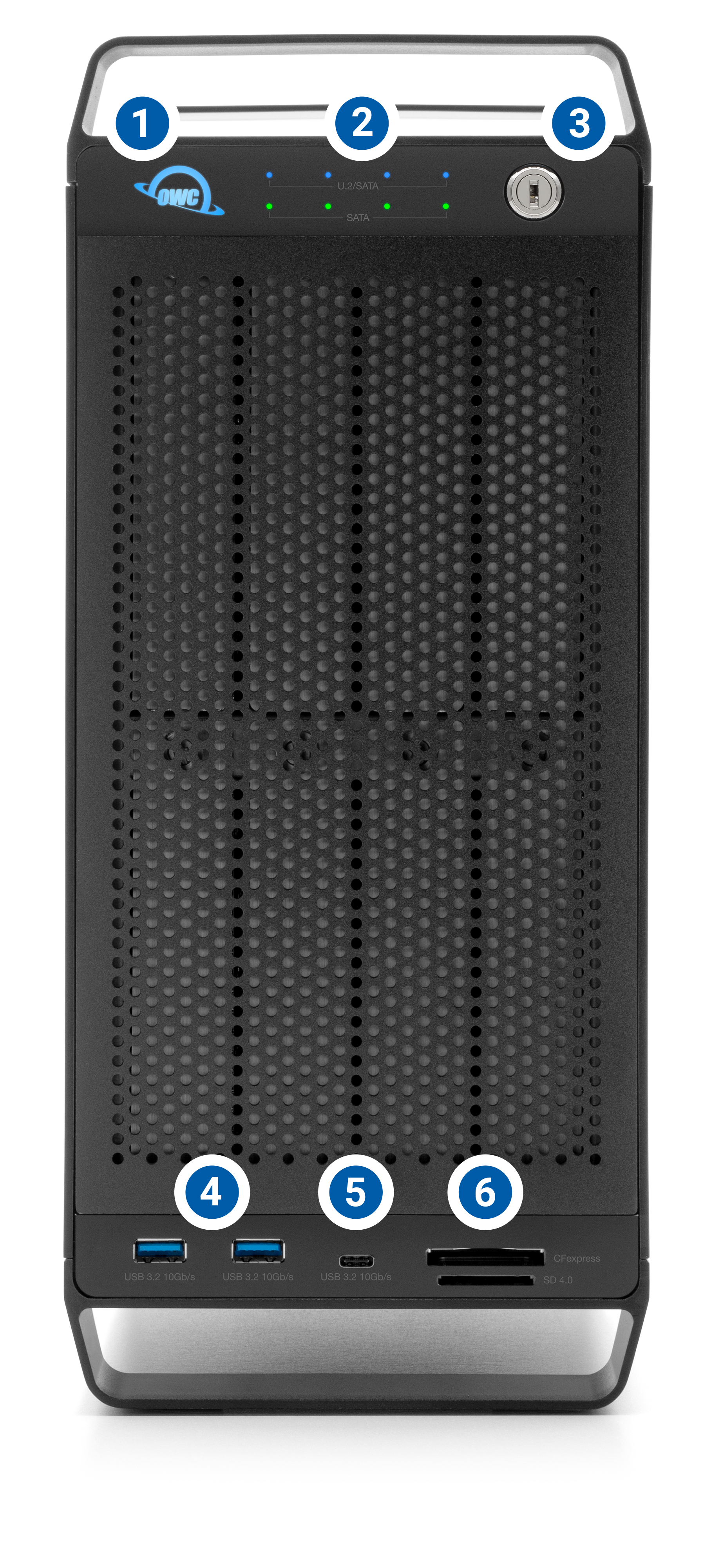
1.4 Rear View
- PCIe Slot Cover – Becomes replaced by available I/O ports of any installed PCIe card. GPUs are not supported.
- Thunderbolt 3 Ports – Connect a compatible host to the 85W port. Connect Thunderbolt devices to the 15W port.
- DisplayPort 1.4 – connect a DisplayPort display here.
- Kensington Security slot – Attach a Kensington Security lock.
- Power Port – Connect the power cable to power the device
- Power Switch – Engage and disengage power to the device
- Power light – additional power indicator.
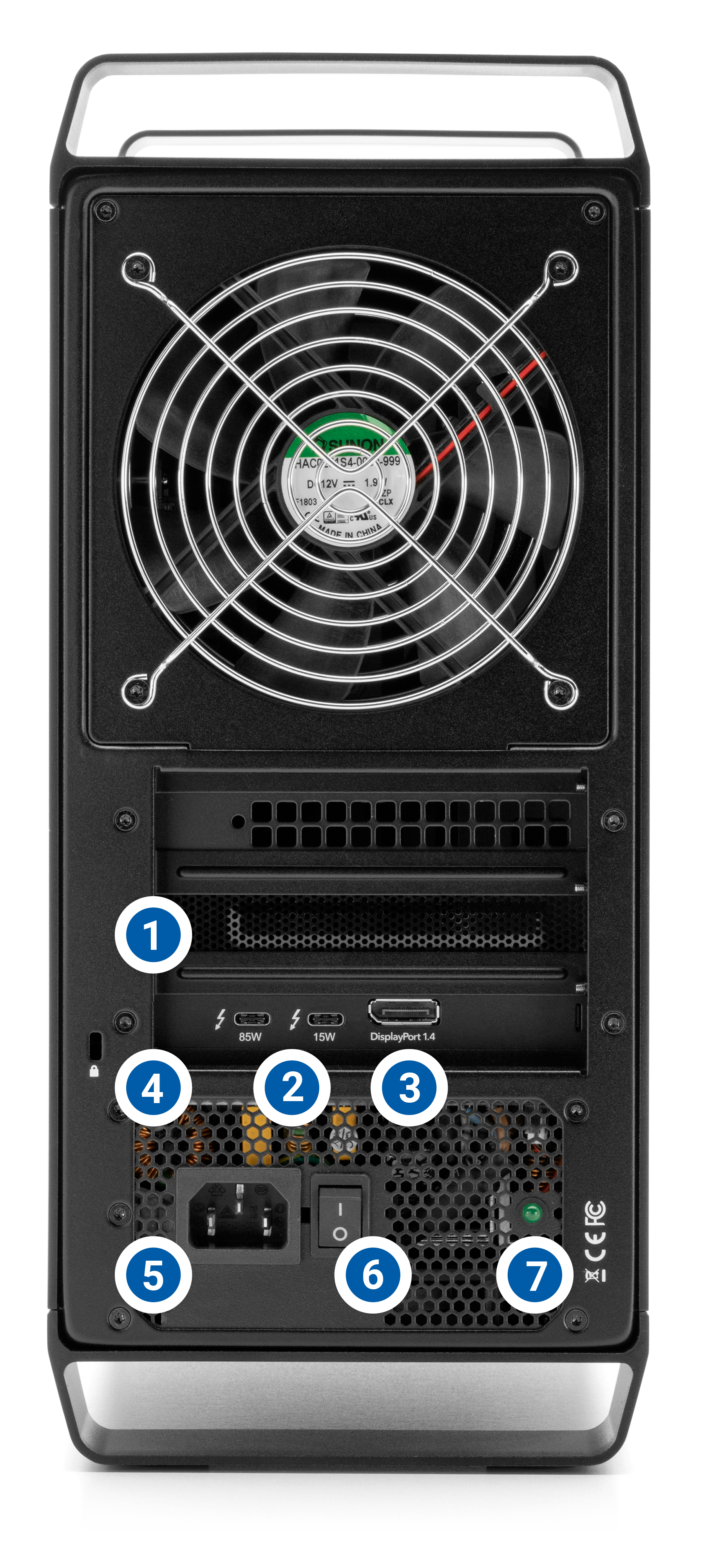
Getting Started
2.1 Device Setup
This section describes the process of setting up the OWC ThunderBay Flex 8 if purchased with pre-installed drives. The OWC ThunderBay Flex 8 is available with a variety of assemblies and configurations.
- If the OWC ThunderBay Flex 8 is assembled with (8) SATA drives.
- All drives are configured as a SoftRAID RAID 5.
- If the OWC ThunderBay Flex 8 is assembled with (7) SATA drives and (1) U2 Shuttle containing (4) NVMe drives.
- The SATA drives are configured as a SoftRAID RAID 5, and the U2 Shuttle is configured as a SoftRAID RAID 0.
- If the OWC ThunderBay Flex 8 is assembled with (7) SATA drives and (1) U2 ShuttleOne containing (1) NVMe drives.
- The SATA drives are configured as a SoftRAID RAID 5, and the U2 ShuttleOne is configured as a SoftRAID RAID 0.
- If the OWC ThunderBay Flex 8 is assembled with (2) U2 Shuttles containing a total of (6) NVMe SSDs.
- All drives are configured as a SoftRAID RAID 0
- Plug the power cable into the OWC ThunderBay Flex 8 power port located on the back and into a power outlet. The Power LED will illuminate a solid white.
- Connect the included Thunderbolt cable the 85W Thunderbolt 3 ports located on the back of the OWC ThunderBay Flex 8 and into a system. The Power LED will illuminate a solid blue.
- Downloading and installing the latest version of SoftRAID is recommended to experience the best performance.
- NOTE: OWC ThunderBay Flex 8 devices come bundled with "3 Years of SoftRAID Premium Access". Please visit OWC SoftRAID Product Details for more information regarding SoftRAID and the bundled Premium Access.
- NOTE: The OWC SoftRAID License is located on bottom of device.
Mac OWC SoftRAID Setup
- Download OWC SoftRAID for Mac.
- Please review and follow the steps outlined in OWC SoftRAID Installation for Mac.
2.2 Assembly Options
The OWC ThunderBay Flex 8 offers multiple drive and RAID configuration options. This device supports 3.5”/2.5” SATA, SAS, and U.2 drives/adapters.
NOTE: U.2 drives and adapters are only supported in the top 4 bays of the OWC ThunderBay Flex 8:
- (8) SATA HDDs configured as a SoftRAID RAID 0, 1, 10(1E), 3, 5, 6, 30, 50, 60, Single Disk, or JBOD
- (4) NVMe M.2 SSDs assembled in a U.2 adapter (OWC Shuttle) configured as a SoftRAID RAID 0, and (7) SATA HDDs configured as a SoftRAID RAID 5
- (1) NVMe M.2 SSD assembled in a U.2 adapter (OWC ShuttleOne) configured as a Single Disk, and (7) SATA HDDs configured as a SoftRAID RAID 5
- (6) NVMe M.2 SSDs assembled in (2) U.2 adapters (OWC Shuttle) configured as a SoftRAID RAID 0.
2.3 Assembly Steps
This section describes the process of installing drives into the OWC ThunderBay Flex 8 if purchased as a bare enclosure.
1. Insert one of the included faceplate keys vertically into the lock located near the upper right corner of the faceplate.
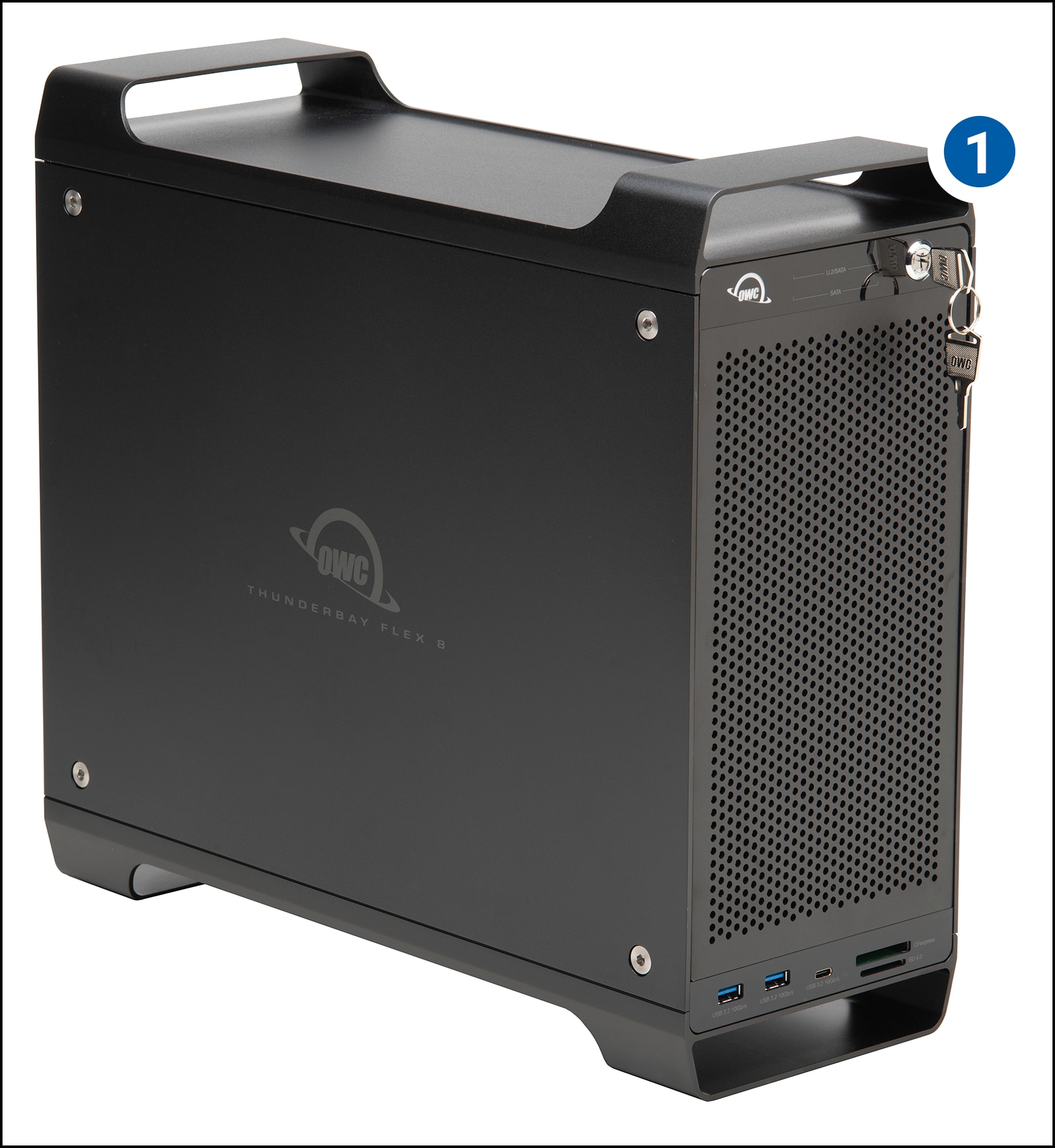
2. Turn the key clockwise into a horizontal position. Push the bottom to swing open the faceplate from the top.
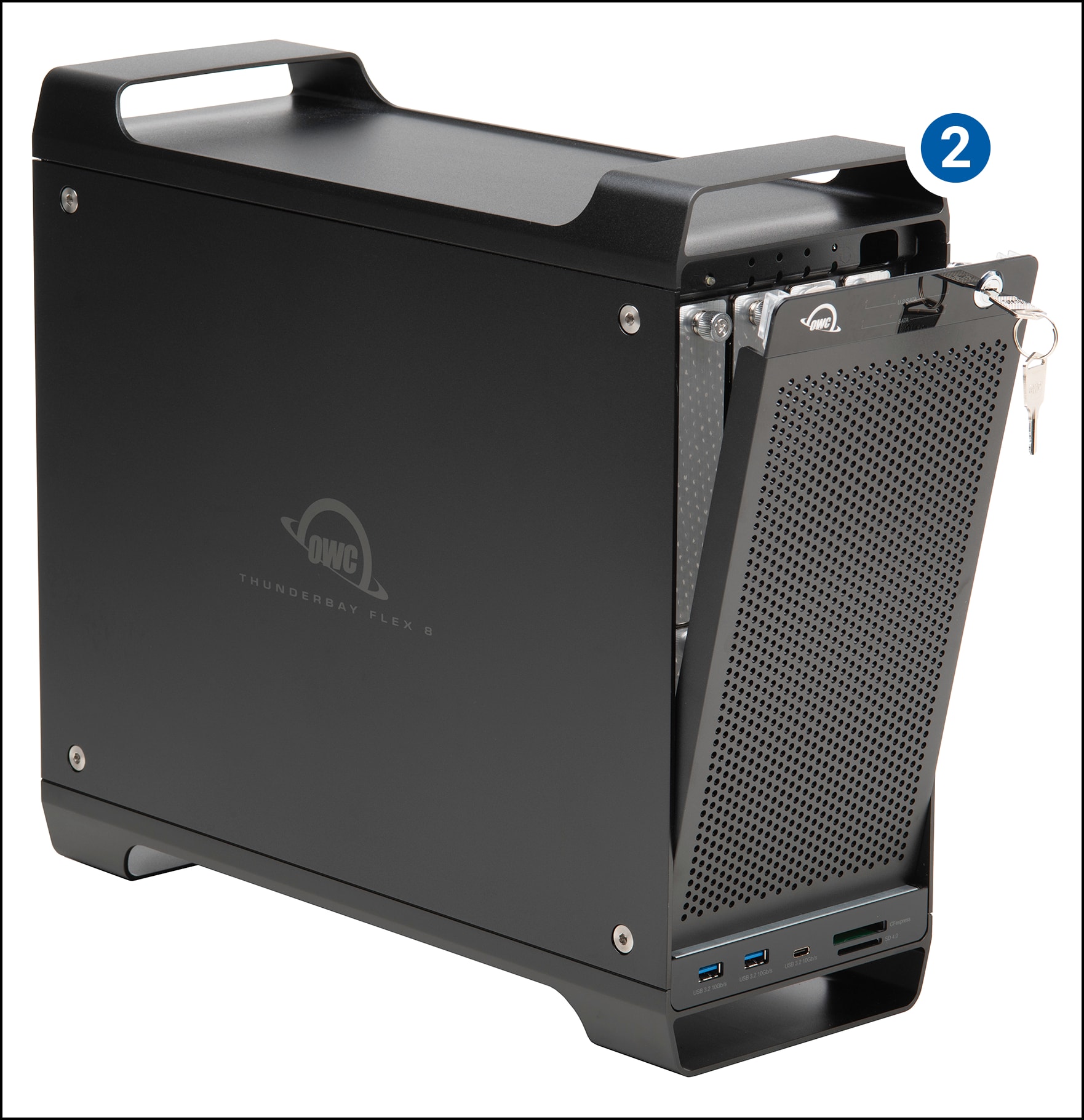
3. Lift and remove the faceplate once fully swung open.
- NOTE: The inside of the faceplate contains storage for the faceplate keys.
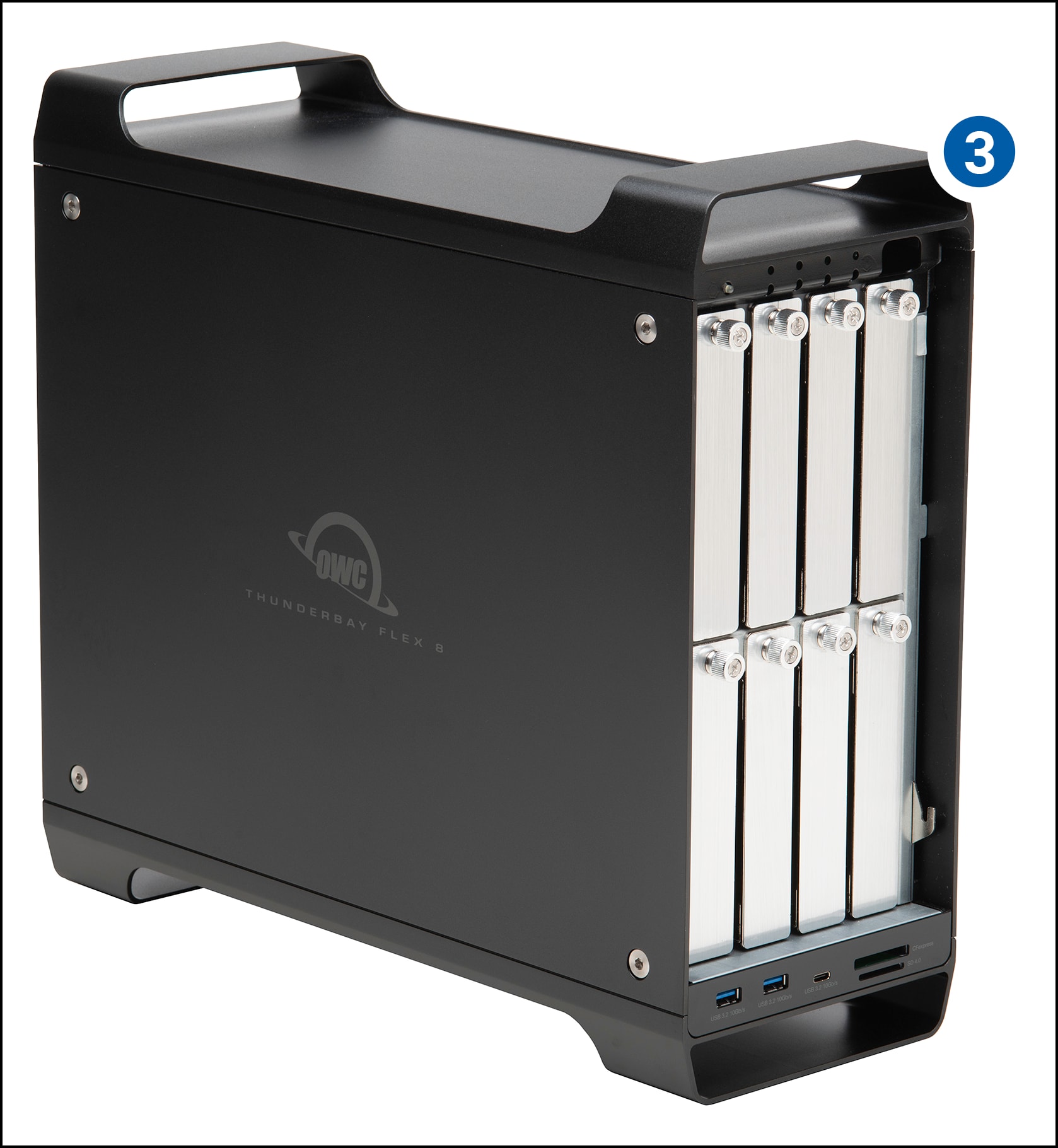
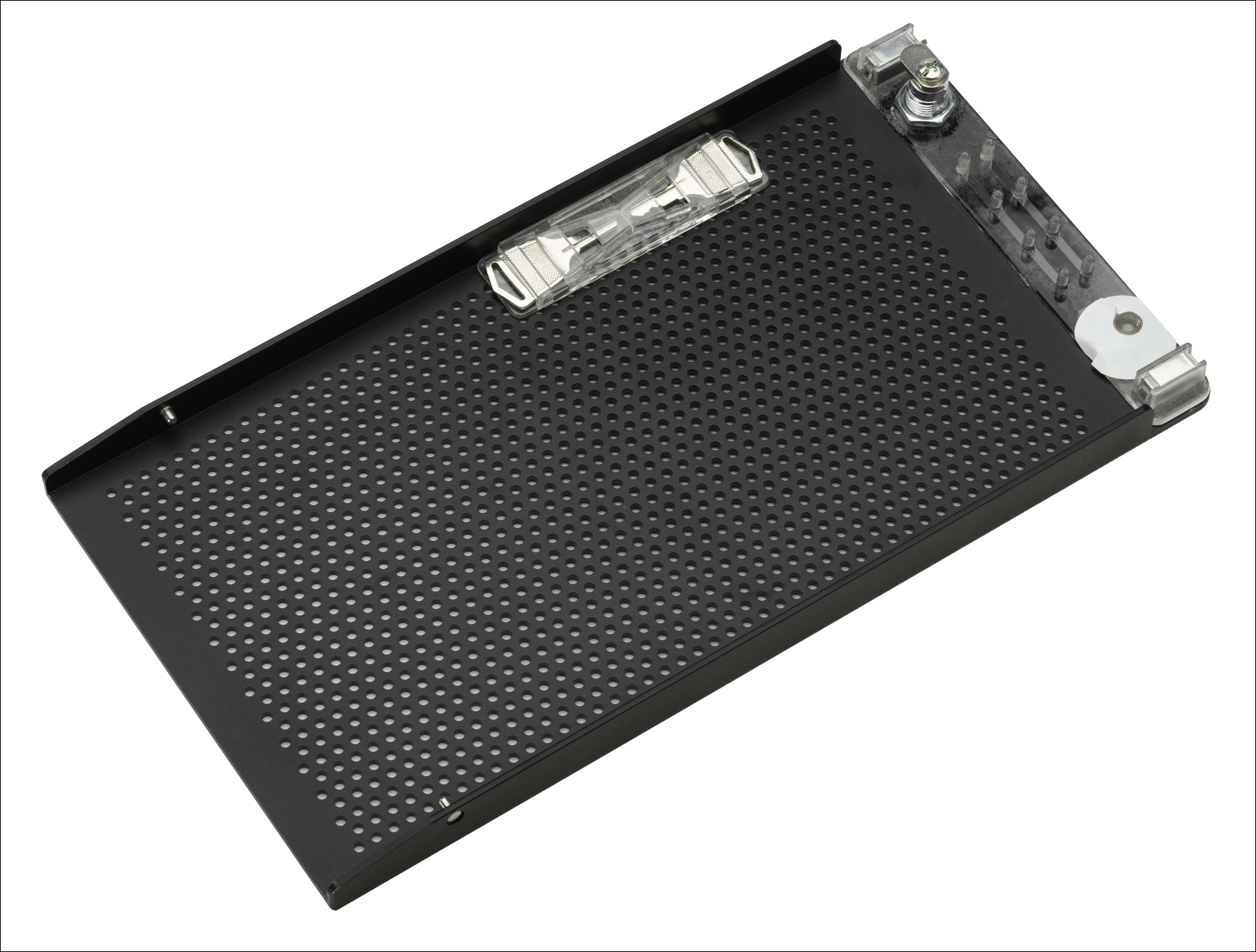
4. For each tray you wish to remove, turn the thumbscrew counter-clockwise until you no longer feel resistance. Then hold onto the thumbscrew and pull the drive tray out.
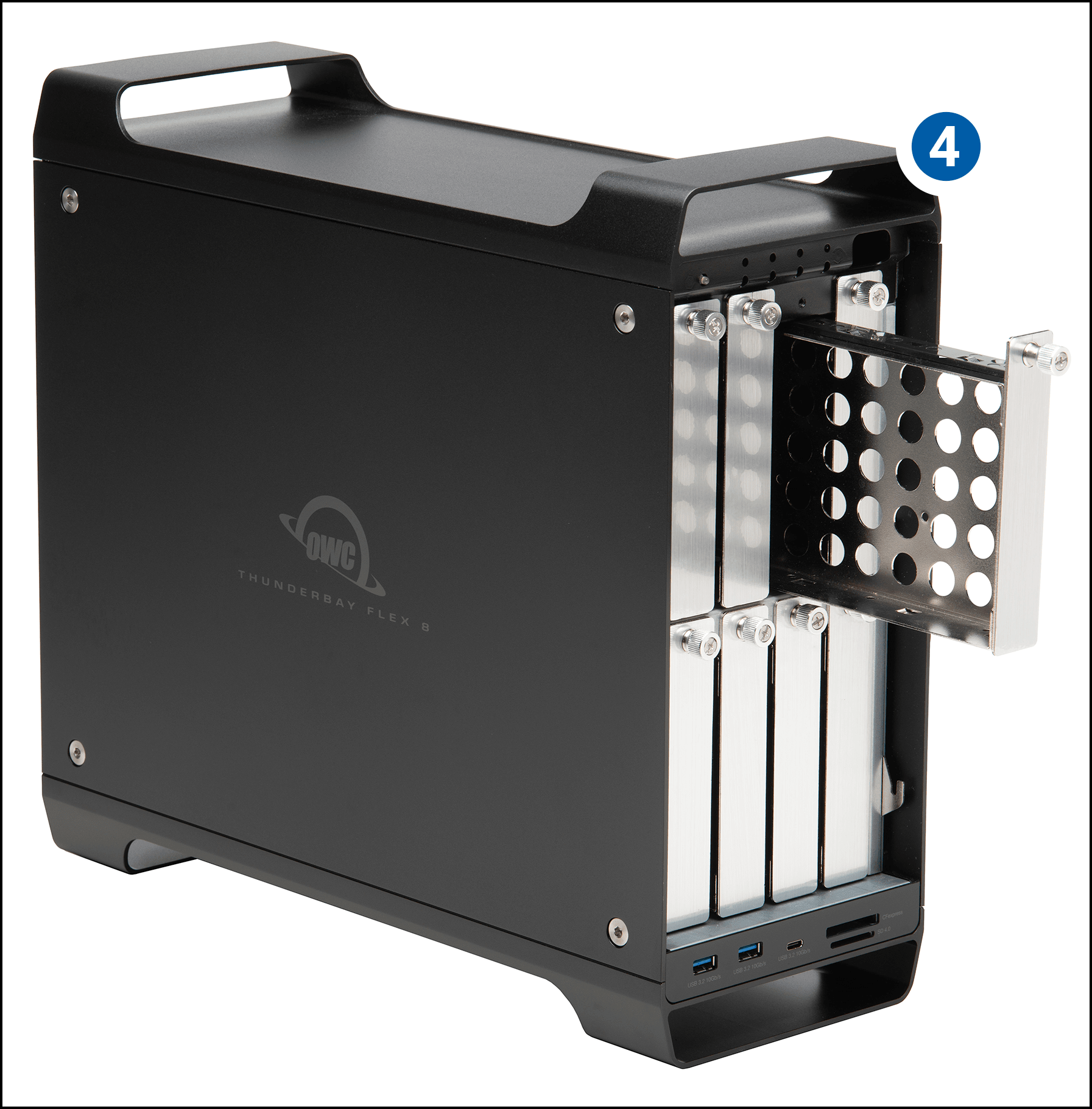
5. Set the drive tray on your work surface as shown. If you are replacing an existing hard drive, unscrew it from the drive tray at this time. Note: the highlighted screw holes are for 2.5-inch drives (SATA or U.2). The holes for 3.5-inch drives are highlighted in green (Step 7).
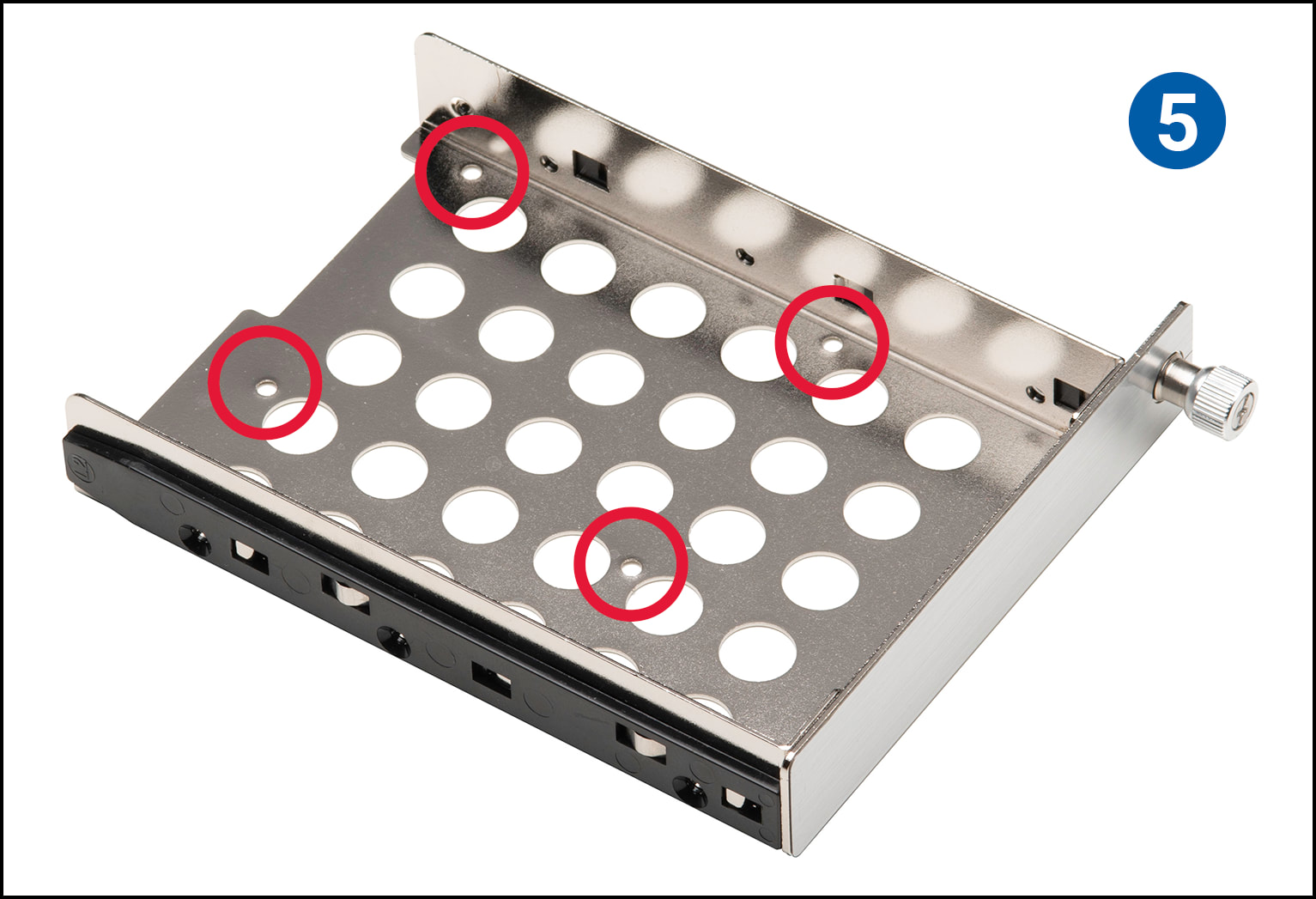
6. Place the hard drive inside the drive tray as shown. The label should face up and the SATA connectors should be on the far rear corner of the drive.
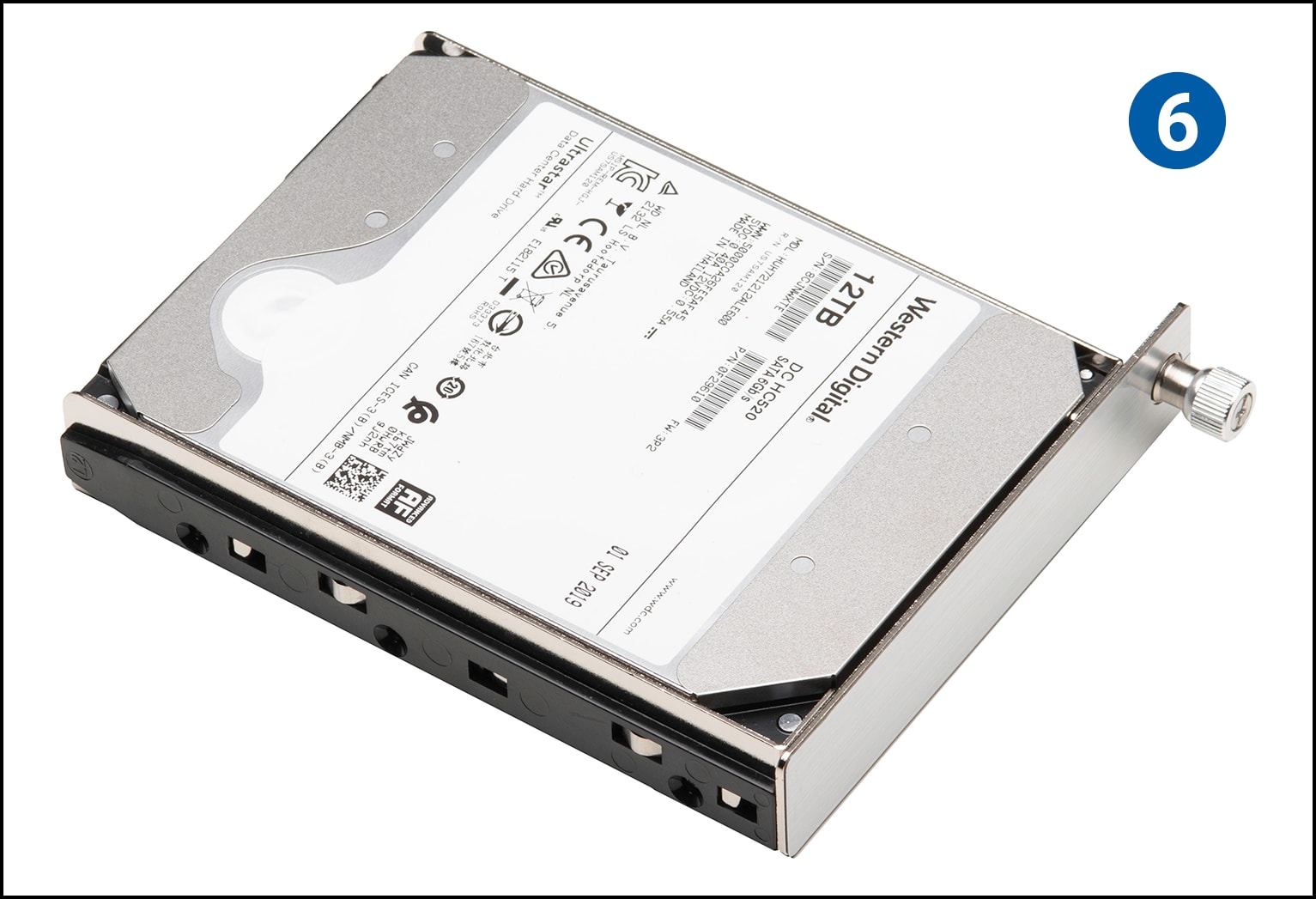
7. Fasten the drive into the drive tray using six of the included screws (three per side). 2.5-inch drives require four of the fine-thread screws.
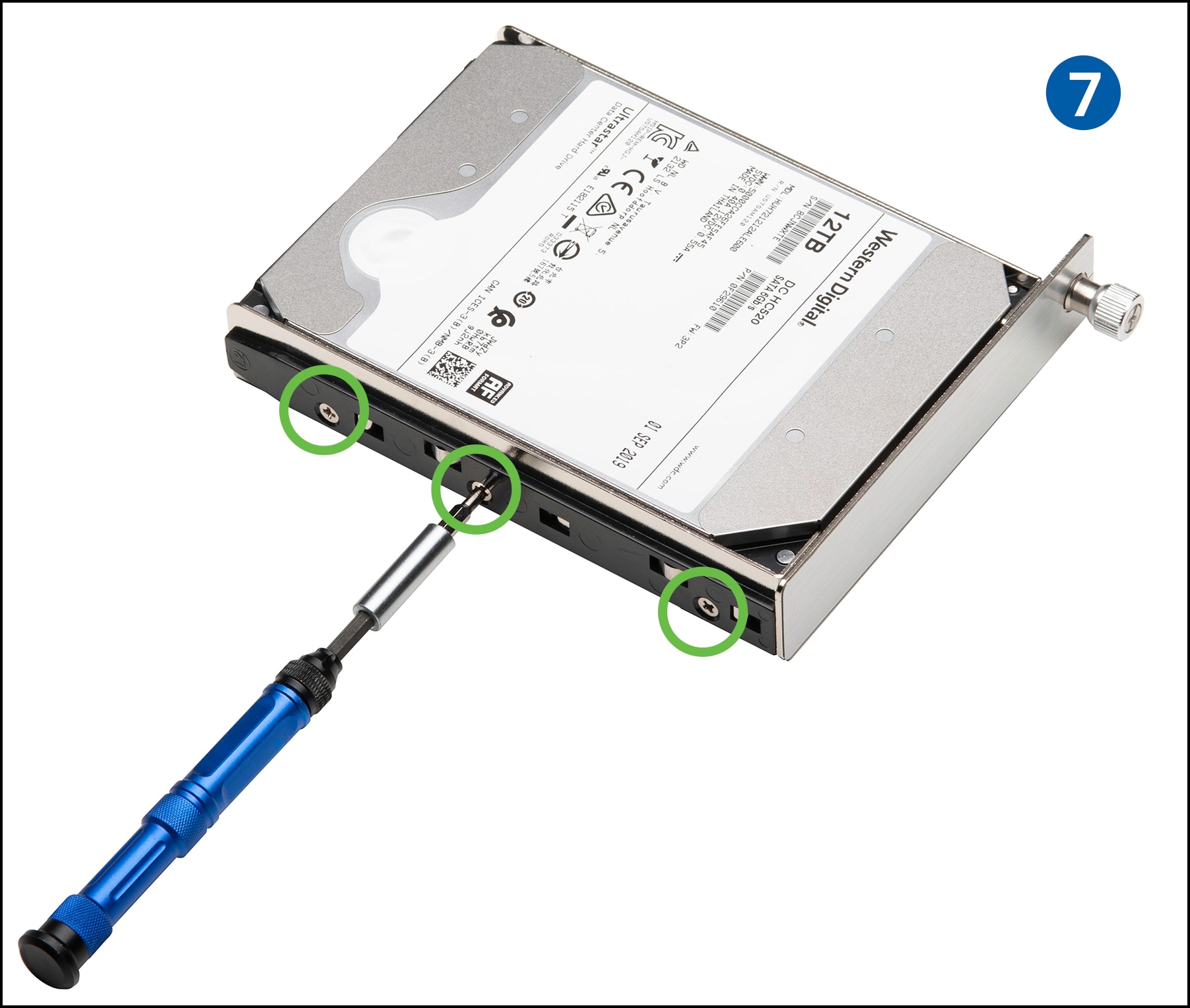
8. Slide the drive tray back into the rails in the ThunderBay Flex 8 and push until it is seated fully, then push in on the thumbscrew and turn it clockwise until it stops turning. If you encounter resistance, do not force the drive tray. Remove it, check to make sure there are no obstructions and that the drive tray is lined up correctly, then try again.
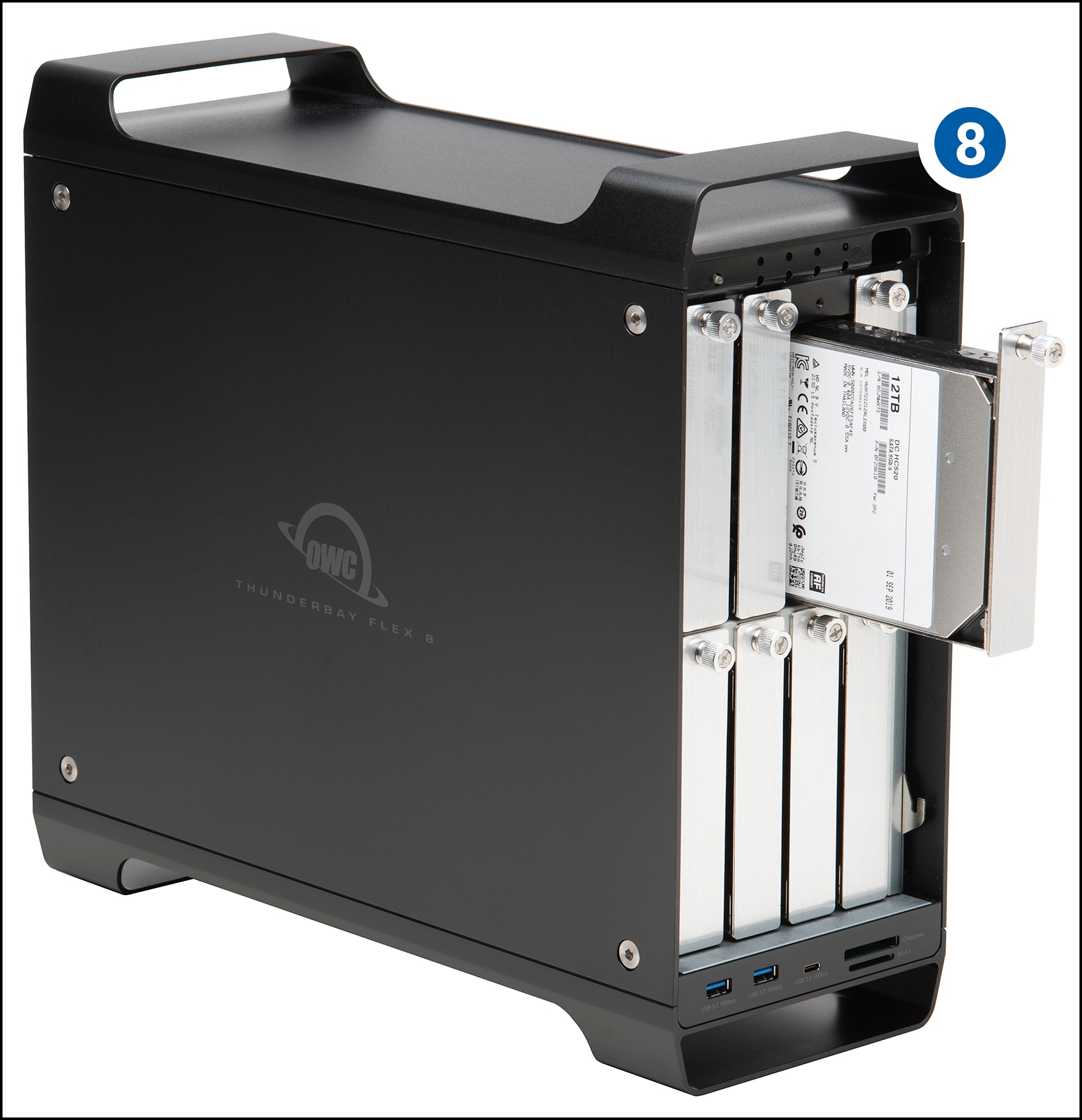
9. Plug the power cable into the OWC ThunderBay Flex 8 power port located on the back and into a power outlet. The Power LED will illuminate a solid white.
10. Connect the included Thunderbolt cable into one of the two Thunderbolt 3 ports located on the back of the OWC ThunderBay Flex 8 and into a system. The Power LED will illuminate a solid blue.
11. The installed drives are ready to be formatted. Move onto Section 2.5 “RAID Configuration Options” for instructions on how to format and configure the OWC ThunderBay Flex 8.
2.4 PCIe Card Assembly Steps (Optional)
This is an optional section that describes the process of install a PCIe card in the OWC ThunderBay Flex 8.
1. As you face the front of the device, the side-panel on the left needs to be removed. Use the included hex key to loosen and remove the four fasteners holding the panel in place.

2. Remove the side cover and set it aside.
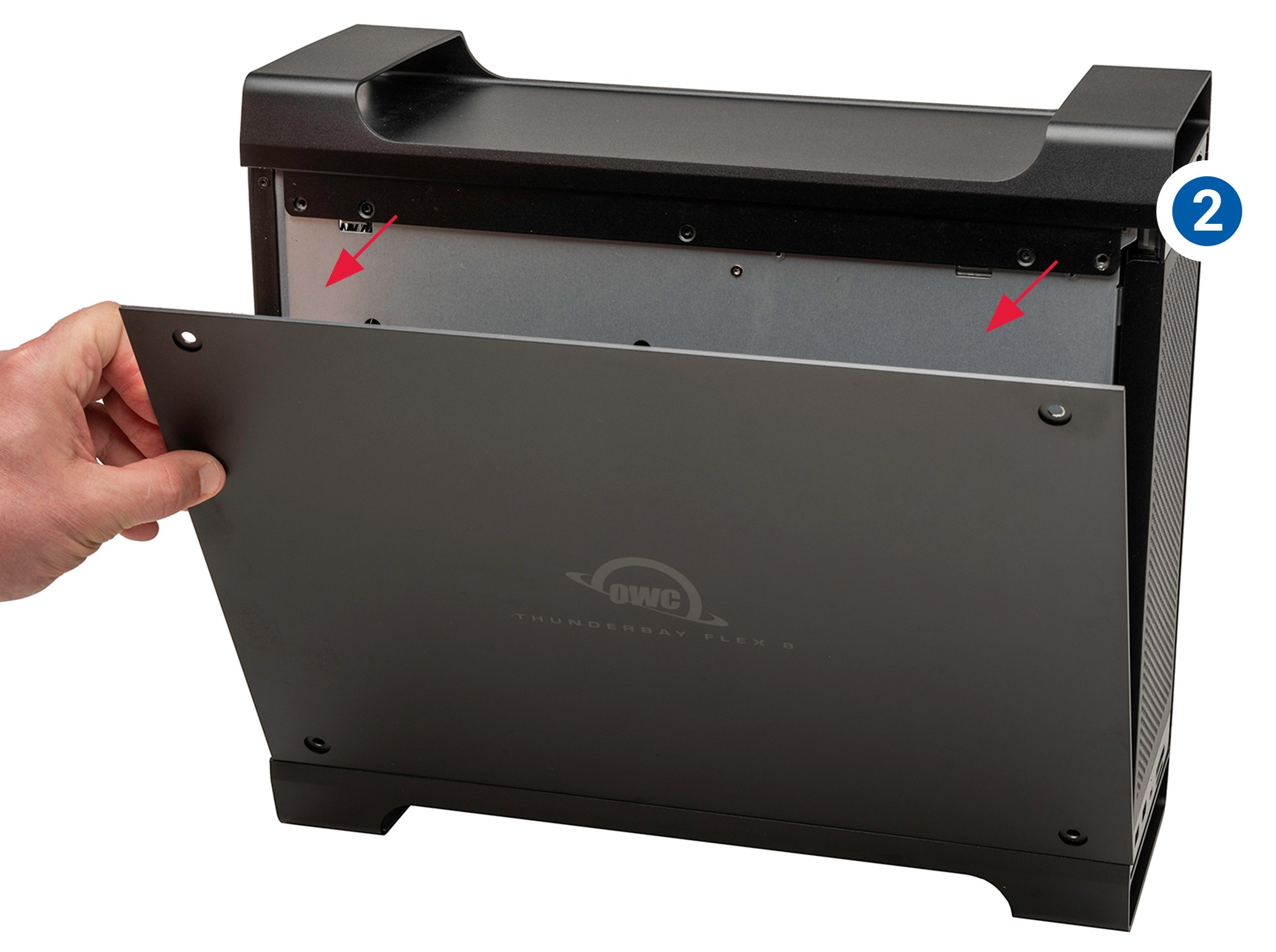
3. Remove the PCIe slot cover then set the screw aside. Store the slot cover; it will not be needed to complete this installation.
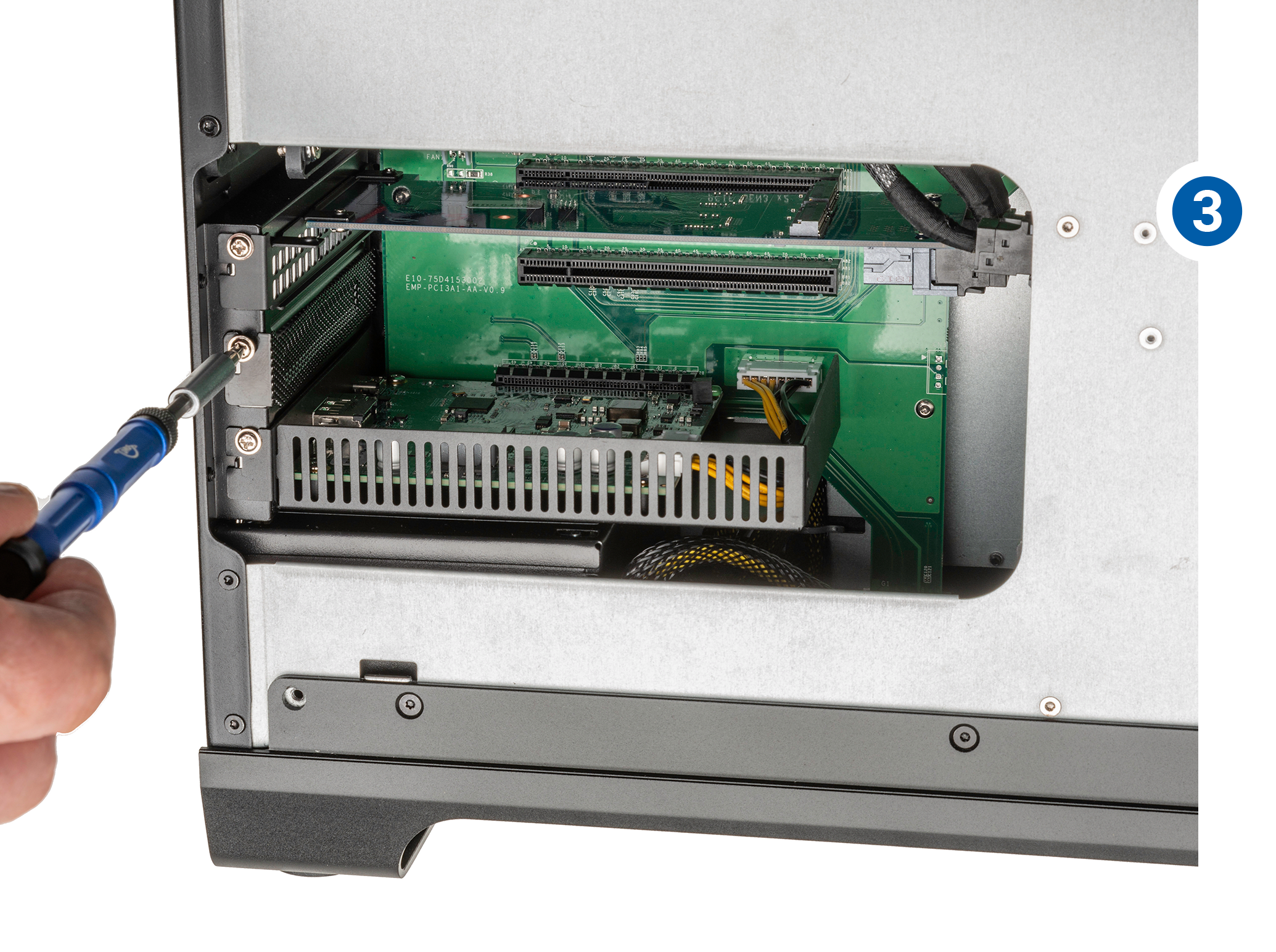
4. Align your PCIe card’s connector with the open slot then install the card as you normally would when installing into a desktop computer.
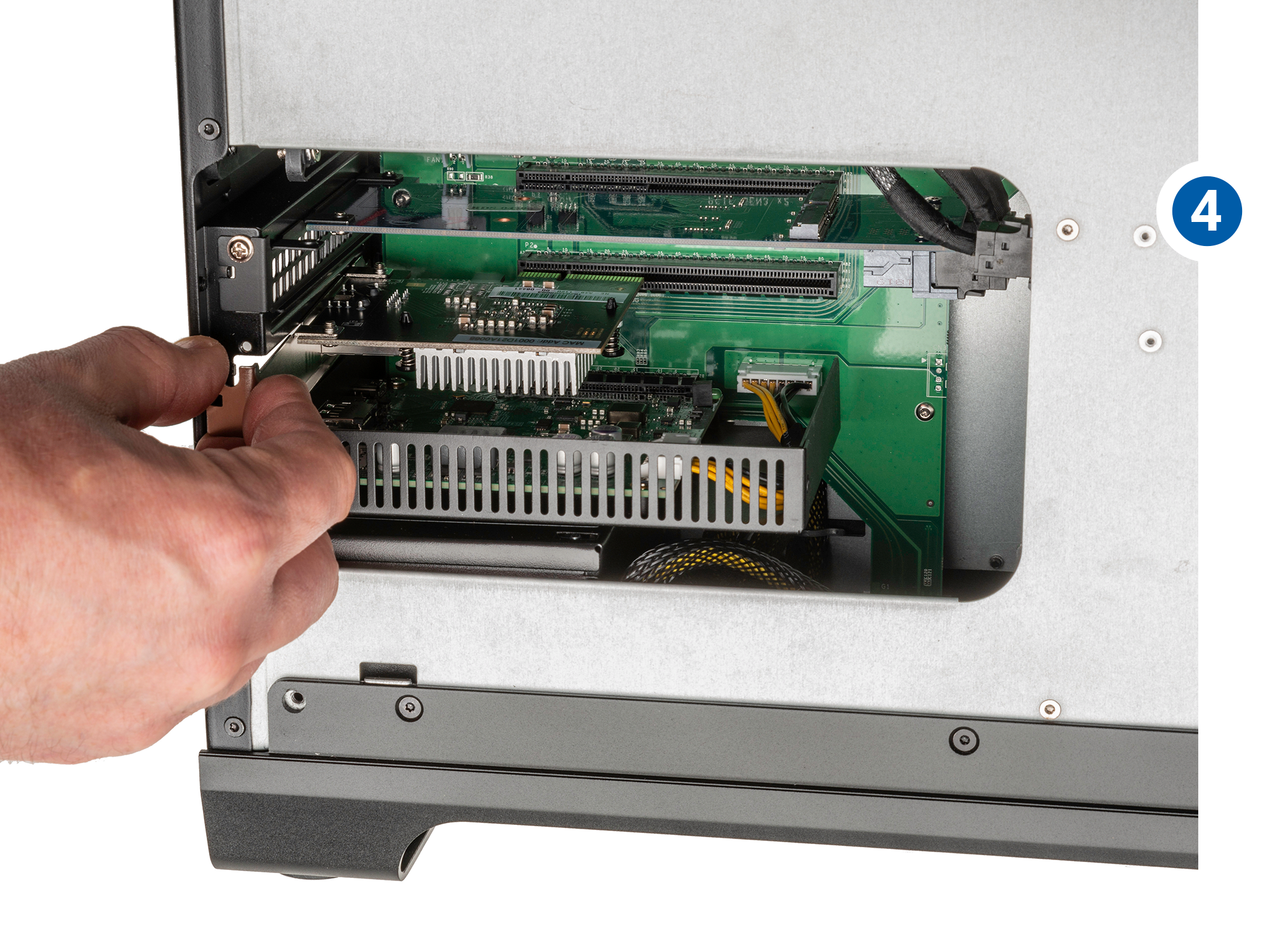
5. Use the screw from Step 3 to affix the card’s bracket to the case.
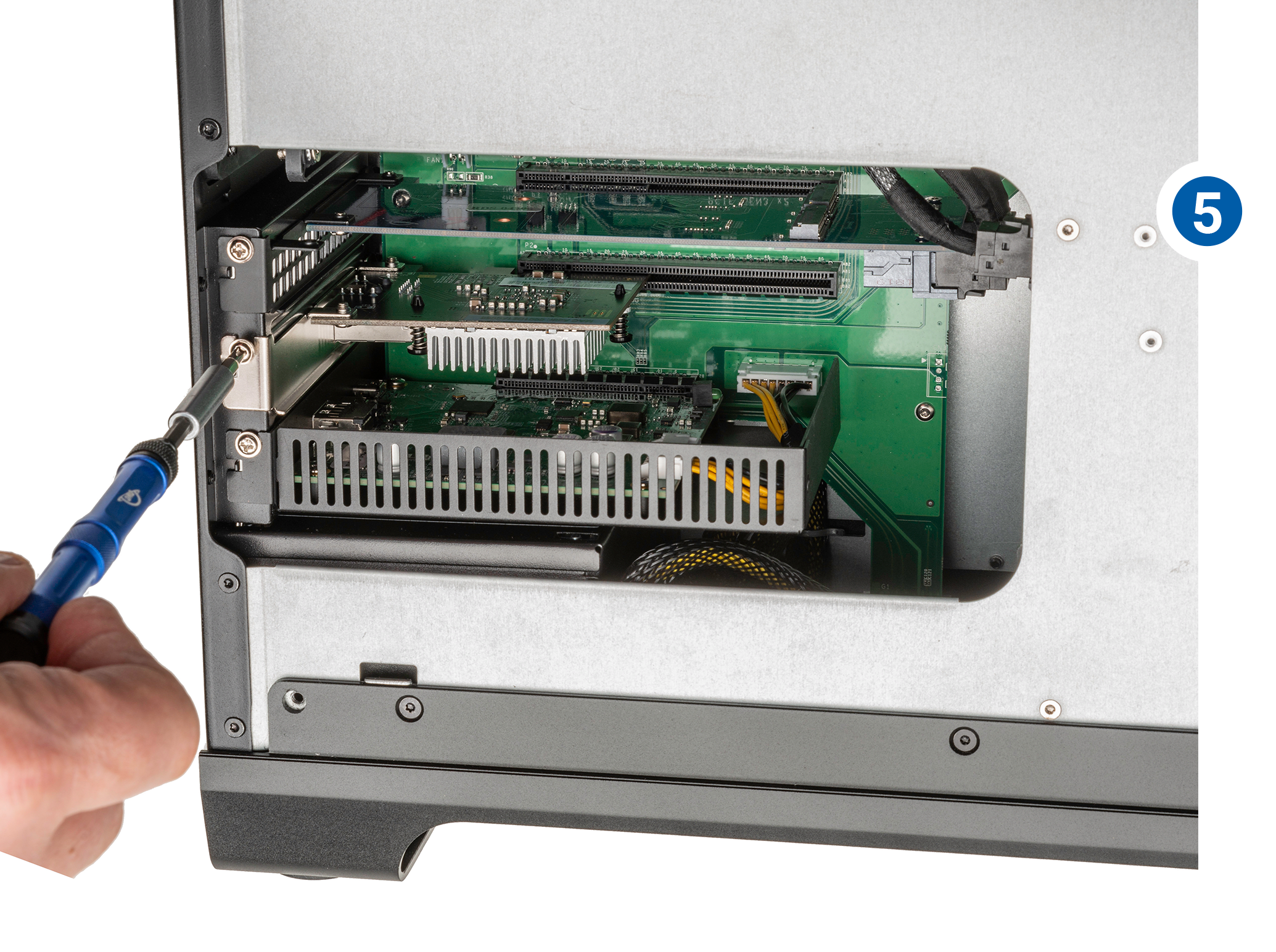
6. If your PCIe card has I/O Ports, double-check the back of the device to ensure the bracket is level / that none of the ports are obscured by the plating on the back of the case. If needed, loosen the screw you set in Step 5, re-align bracket as needed, and re-tighten the screw.

7. Set the side cover back on the case, making sure the holes are aligned with the four fastener holes, then re-affix the four fasteners removed in Step 1.

2.5 RAID Configuration Options
OWC SoftRAID RAID Configuration
- Downloading and installing the latest version of OWC SoftRAID is recommended to experience the best performance from the OWC ThunderBay Flex 8.
- NOTE: OWC ThunderBay Flex 8 devices come bundled with "3 Years of SoftRAID Premium Access". Please visit OWC SoftRAID Product Details for more information regarding SoftRAID and the bundled Premium Access.
- SoftRAID will assist with formatting the installed drives and setting up a RAID volume.
- NOTE: The OWC SoftRAID license is located on the bottom of the device.
Mac OWC SoftRAID Setup
- Download OWC SoftRAID for Mac.
- Please review and follow the steps outlined in OWC SoftRAID Installation for Mac.
- Please review and follow the instructions outlined in Creating a macOS OWC SoftRAID Volume.
Mac RAID Configurator
- Open the “Disk Utility” application on your Mac.
- Choose “File” and select “RAID Assistant”.
- Select a set type:
- Striped (RAID 0) set: A striped RAID set can speed up access to your data. You can’t create a RAID set on your startup disk; you must first start up your computer from another disk.
- Mirrored (RAID 1) set: Protect your data against hardware failure with a mirrored RAID set. When you create a mirrored RAID set, your data is written to multiple disks so the information is stored redundantly. You can’t create a RAID set on your startup disk; you must first start up your computer from another disk.
- Concatenated (JBOD) set: Increase storage space with a concatenated disk set. If you need one large disk, but you have several smaller disks, you can create a concatenated disk set to use as one large disk.
- Select the checkboxes of the disks you want to include in the set.
- For each disk, click the pop-up menu in the Role column and choose “RAID slice” or “Spare” to designate the disk as a standard member or spare in the set, then click Next.
- Enter a name for the RAID set in the RAID Name field.
- Click the Format pop-up menu, then choose a volume format that you want for all the disks in the set. (See File system formats available in Disk Utility.)
- Click the “Chunk size” pop-up menu, then choose a disk chunk size that you want used for all the disks.
- When you create a striped set, chunks of data from the same file are distributed across the drives. Ideally, you want data distributed across drives evenly and at an optimum size so that it can be efficiently accessed. If you want high data throughput from your set, choose a smaller chunk size so that data is spread across the drives and one drive can be accessing data while another is seeking the next chunk. With mirrored disk sets, choose a chunk size that matches the data you’re accessing. For example, when working with video files, your Mac is accessing large chunks of data, whereas when using a database of many small records, your disks may be accessing smaller chunks of information.
- If you are creating a mirrored RAID set, select the “Automatically rebuild” checkbox to allow the set to be automatically rebuilt when member disks are reconnected
- Click "Create" and then click "Done".
Device Management
3.1 Drive Failure
- If the OWC ThunderBay Flex 8 was configured as a RAID 0, the data on the array is lost and the disk is no longer usable.
- If the OWC ThunderBay Flex 8 was configured as a RAID 5, the RAID card will alert the user with a beeping tone. The RAID can continue to be used, but the drive should be replaced immediately.
3.2 Replacing Drives
- The Hot-Swap function can be used to rebuild disk drives in arrays with data redundancy such as RAID level 1, 3, 5, 6, 10, 30, 50 and 60. The data will remain accessible via the functioning drive until the array is rebuilt with a new drive.
- If the enclosure was purchased with drives and it is still under warranty, contact OWC technical support for assistance (see Section 4.4 “Contacting Support”). If the unit is outside its warranty or was purchased without drives, follow the assembly instructions to access and replace the failed drive.
- NOTE: A failed drive must be replaced with an identical drive (model, capacity, firmware). Refer above to section 2.3 “Assembly Steps” for drive replacement steps.
- NOTE: The OWC ThunderBay Flex 8 needs an active data signal to remain powered on. If it is disconnected from the computer, or if the computer goes to sleep or turns off, the device will power off. To minimize the rebuild time, it is recommended to keep the device connected to the computer (with the computer powered on), and disable any drive sleep settings on the computer for the duration of the rebuild.
- If the enclosure was purchased with drives and it is still under warranty, contact OWC technical support for assistance (see Section 4.4 “Contacting Support”). If the unit is outside its warranty or was purchased without drives, follow the assembly instructions to access and replace the failed drive.
3.3 Manually Unmounting Volumes
To ensure no data is lost during normal use, always eject or unmount the corresponding volume(s) from the operating system before powering off and disconnecting the device. Unmounting options are provided below.
macOS
- Drag the icon for the device you wish to unmount to the trash can; OR
- Right-click the device icon on the desktop, then click “Eject”; OR
- Highlight the device on your Desktop and press Command-E.
3.4 OWC Innergize Software
A software application included with OWC Atlas media cards that currently provides three basic functionalities to the user: Health, Sanitize and Field Firmware Upgradability.
- The Health function allows the user to know how much life is left on their OWC Atlas media card
- Sanitize removes ghost data on OWC Atlas media cards which will allow the media cards to perform at their peak and out of factory condition performance in matter of seconds
- Field Firmware upgradability allows OWC to deliver live updates to our memory cards without the hassle of sending them in for an update.
Installing OWC Innergize
- Download OWC Innergize application based on the system:
- Open the downloaded file to begin and complete the installation process.
- For additional information regarding OWC Innergize please consult the support manual "OWC Innergize User Guide"
Required Firmware Update
OWC Innergize requires a firmware update to work properly with select OWC Memory Card Readers, Docks, and Storage Solutions.
- Ensure the OWC ThunderBay Flex 8 is powered and connected to a compatible system with the included data cable.
- Insert an OWC Atlas SDXC memory card into the SD Media Slot of the OWC ThunderBay Flex 8. Align the memory card notches with the internal card reader connections. The gold contacts should be facing left when the memory card is inserted. This allows the system to recognize the card reader.
Windows Users
- Download the OWC Innergize Firmware Update for the OWC ThunderBay Flex 8.
- Access the system Downloads folder and open the downloaded Compressed Folder. The compressed folder will open showing a firmware updater folder, and PDF/Word instructions for completing the firmware update process. Before accessing the firmware updater folder, open the instructions and proceed through the provided steps.
Mac Users
- Additional steps are required to complete the installation of the firmware. The firmware update is completed through the Windows operating system, therefore a Windows operating system emulator “Parallels” will need to be downloaded.
- For additional information regarding the OWC Innergize for Mac firmware update please consult the support article based on the system: "Innergize for Mac: Firmware Update".
3.5 Usage Notes
- U.2 drives supported only in the top 4 drive bays. The left-most bay provides x4 PCIe lanes for maximum performance; the remaining three provide x1 lanes each.
- Users planning to install an OWC U2 Shuttle should note the device is designed so that only one LED illuminates, and that is drive bay SSD_D. The LED function associated with an OWC U2 Shuttle will be disabled and not function if drive bay SSD_D is absent of a M.2 SSD.
- 2.5-inch or 3.5-inch SATA drives accepted in all 8 bays.
- Front USB ports can connect at up to 10Gbps even though they are Type-A ports (USB 3.2 Gen 2).
- Thunderbolt device chains can support up to six Thunderbolt devices.
- The OWC SoftRAID License is located on bottom of device.
- By using the DisplayPort feature, the overall performance of the drive may decrease somewhat, as the DisplayPort shares bandwidth with the Thunderbolt 3 ports. The same is true if you connect a display to one of the available Thunderbolt 3 ports (this can be done with either a native Thunderbolt 3 display or with a Thunderbolt 3 display adapter).
- Thunderbolt 3 is backwards compatible with Thunderbolt 2 and Thunderbolt, but speeds can be impacted depending on where in the chain a device is connected. If mixing Thunderbolt 3 with Thunderbolt 2 and/or Thunderbolt devices, use the device order shown below, if possible. Computer > Thunderbolt 3 devices > Thunderbolt 2 devices > Thunderbolt devices.
- SAS drives – Use of SAS drives requires the installation of a PCIe SAS controller (sold separately).
- To ensure no data is lost during normal use, always eject or unmount the corresponding disk(s) from your operating system before powering off the device. Several options are provided below for Mac.
- Drag the icon for the disk you wish to unmount to the trash can; OR
- Right-click the disk icon on the desktop, then click “Eject”; OR
- Highlight the disk on your Desktop and press Command-E.
Support Resources
4.1 Troubleshooting
- Begin troubleshooting by verifying that the power cable is connected to the OWC ThunderBay Flex 8 and to a power source. If the power cable is connected to a power strip, make sure that the power switch on the strip is turned on. Then, verify that the Thunderbolt 3 cable is properly plugged into the computer and the OWC ThunderBay Flex 8.
- If the OWC ThunderBay Flex 8 is still not working properly, try connecting to another computer or using another Thunderbolt 3 cable. When the computer goes to sleep, the OWC ThunderBay Flex 8 will go to sleep. If you are still experiencing problems, consult Section 4.4 for OWC technical support contact information.
- If the OWC ThunderBay Flex 8 volume isn’t appearing on the Mac system, ensure the driver is installed by going to System Information > PCIe, and verify that “Driver Installed” says yes.
4.2 Online Resources
4.3 About Data Backup
To ensure that your files are protected and to prevent data loss, we strongly suggest that you keep two copies of your data: one copy on your OWC ThunderBay Flex 8 and a second copy on your internal drive or another storage medium, such as an optical backup, or on a second external storage unit. Any data loss or corruption while using the ThunderBay Flex 8 is the sole responsibility of the user, and under no circumstances may OWC, its parent, partners, affiliates, officers, employees, or agents be held liable for loss of the use of data including compensation of any kind or recovery of the data.
4.4 Contacting Support
- Phone: M–F, 9am–6pm CT USA 1-866-692-7100 | INTL +1-815-338-4751
- Chat: M–F, 8am–8pm, Sat 9am–5pm CT www.owc.com/support
- Email: Answered within 48 hours www.owc.com/support
4.5 About This Manual
The images and descriptions may vary slightly between this manual and the unit shipped. Functions and features may change depending on the firmware version. The latest product details and warranty information can be found on the product web page. OWC’s Limited Warranty is not transferable and subject to limitations.
General Use Precautions
- To avoid damage, do not expose the device to temperatures outside the following ranges:
- Environmental (Operating)
- Temperature (ºF): 50º — 95º
- Temperature (ºC): 10º — 35º
- Environmental (Non-Operating)
- Temperature (ºF): -40º — 149º
- Temperature (ºC): -40º — 65º
- Environmental (Operating)
- Always unplug the device from the electrical outlet if there is a risk of lightning or if it will be unused for an extended period of time. Otherwise, there is an increased risk of electrical shock, short-circuiting or fire.
- Do not use the device near other electrical appliances such as televisions, radios or speakers. Doing so may cause interference which will adversely affect the operation of the other products.
- Do not place the device near sources of magnetic interference, such as computer displays, televisions or speakers. Magnetic interference can affect the operation and stability of hard drives.
- Do not place objects on top of the device.
- Protect your device from excessive exposure to dust during use or storage. Dust can build up inside the device, increasing the risk of damage or malfunction.
- Do not block any ventilation openings on the device. These help to keep the device cool during operation. Blocking the ventilation openings may cause damage to the device and cause an increased risk of short-circuiting or fire.
Safety Precautions
- Read this user guide carefully and follow the recommended steps for assembly.
- Use proper anti-static precautions while installing drives into this enclosure. Failure to do so can cause damage to your drive mechanisms and/or the enclosure.
- Do not attempt to disassemble or modify the device. To avoid any risk of electrical shock, fire, short-circuiting or dangerous emissions, never insert any metallic object into the device. If it appears to be malfunctioning, please contact technical support.
- Never expose your device to rain, or use it near water or in damp or wet conditions. Never place objects containing liquids on the drive, as they may spill into its openings. Doing so increases the risk of electrical shock, short-circuiting, fire or personal injury.
Caution!
User proper anti-static precautions
- Discharge static electricity before beginning
- Work on a static free surface
Terms & Conditions of Sale
Warranty
The ThunderBay Flex 8 has a 3 Year OWC Limited Warranty or 5 Year OWC Limited Warranty if it was bundled with drives. ThunderBay Flex 8 enclosures that do not ship with drives have a 1 Year OWC Limited Warranty. For up-to-date product and warranty information, please visit OWC ThunderBay Flex 8 Product Details.
Changes
The material in this document is for information purposes only and subject to change without notice. While reasonable efforts have been made in the preparation of this document to assure its accuracy, OWC, its parent, partners, affiliates, officers, employees, and agents assume no liability resulting from errors or omissions in this document, or from the use of the information contained herein. OWC reserves the right to make changes or revisions in the product design or the product manual without reservation and without obligation to notify any person of such revisions and changes.
FCC Statement
Warning! Modifications not authorized by the manufacturer may void the user’s authority to operate this device.
NOTE: This equipment has been tested and found to comply with the limits for a Class B digital device, pursuant to Part 15 of the FCC Rules. These limits are designed to provide reasonable protection against harmful interference in a residential installation. This equipment generates, uses and can radiate radio frequency energy and, if not installed and used in accordance with the instructions, may cause harmful interference to radio communications. However, there is no guarantee that interference will not occur in a particular installation. If this equipment does cause harmful interference with radio or television reception, which can be determined by turning the equipment off and on, the user is encouraged to try to correct the interference by one or more of the following measures:
- Reorient or relocate the receiving antenna.
- Increase the separation between the equipment and receiver.
- Connect the equipment to an outlet on a circuit different from that to which the receiver is connected.
Copyrights and Trademarks
No part of this publication may be reproduced, stored in a retrieval system, or transmitted in any form or by any means, electronic, mechanical, photocopying, recording or otherwise, without the prior written consent of OWC.
© 2020 Other world Computing, Inc. All rights reserved. OWC, the OWC logo, and ThunderBay are trademarks of New Concepts Development Corporation, registered in the U.S. and/or other countries. Mac and macOS are trademarks of Apple Inc., registered in the U.S. and other countries. Thunderbolt and the Thunderbolt logo are trademarks of Intel Corporation in the U.S. and/or other countries. Other marks may be the trademark or registered trademark property of their owners.
Free Support Chat
Our free award-winning support team is ready to answer all of your questions. Technical support is available Monday - Friday: 9AM - 6PM. Customer Support & Sales is available Monday - Friday: 9AM - 6PM. Support is unavailable on U.S. Federal holidays. Talk to a human today.

 1-800-275-4576
1-800-275-4576